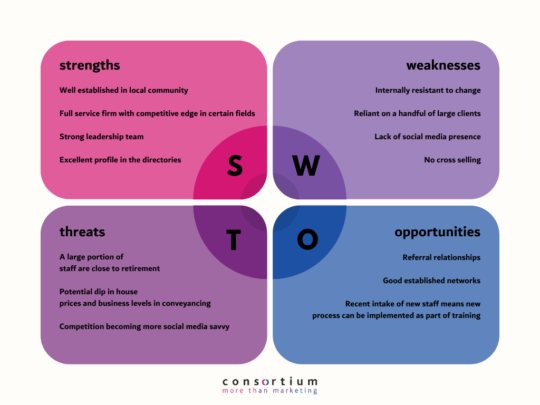Before we look at what makes an effective marketing audit in 2025, we need to look back to Kotler and Keller (2007). They defined the marketing audit as the comprehensive, systematic, analysis, evaluation and interpretation of the business marketing environment, both internal and external, and its goals, objectives, strategies, and principles to ascertain the areas of problem and opportunities and to recommend a plan of action to enhance the firm’s marketing performance.
The Core Principles
If you’re carrying out a Marketing Audit in 2025, keep the following points in mind:
Comprehensive
The Audit needs to be holistic and look at the whole marketing function, not just analyse where a problem exists. An audit looks as much at where elements are performing well as where there is room for improvement.
Systematic
You will need to look at everything that influences marketing performance, whether it does so directly or indirectly. A systematic approach will allow you to analyse the micro and macro environment (using SWOT analysis), as well as your marketing principles, objectives, and strategies.
Independent
We all have biases (whether they’re conscious or not!), and to avoid them clouding the results of the audit, you might want to consider employing a third party to undertake the marketing audit. They’ll also be free of any workplace politics that might currently be preventing the problem from being solved.
When selecting someone to carry out the audit, you will need to allow them to completely submerge themselves in your company culture and activity to get a full picture of the business. While you are asking a third party to actually put together the findings of the audit you will still need to invest some of your own management time in the process if you want to get the best results.
Periodical
The marketing audit should not be a standalone event. A full audit as part of your strategic marketing plan need only be carried out once a year, or even every other year if your processes are really solid. However, it’s a good idea to audit your marketing activities more regularly to make sure you are still on track to meet your objectives. We always audit marketing activity quarterly so we can keep track of how different campaigns or tactics are performing.
The Components of a Marketing Audit in 2025
The first thing to do is to check the feasibility of that which directly impacts the performance of your marketing. These are the Firm’s Mission, Marketing Objectives, Goals and Marketing Strategies. It doesn’t matter how efficient your marketing activity is in achieving the objectives if those objectives are out-of-date or not helping you build towards the company’s future.
The next thing you’ll need to do is write a SWOT analysis. SWOT stands for ‘Strengths, Weaknesses Opportunities, Threats’ and allows you to lay out the macro (external) and micro (internal) factors influencing your business.
Environmental Factors
The Macro-Environment is all the factors outside your business that influence the performance of your marketing. In the SWOT table, this is ‘Opportunities’ and ‘Threats’. Consider Demographic, Economic, Environmental, Political and Cultural impacts on your business. You should also add consider the wider competitor landscape your business is based in. If you’ve ever written out a PESTLE analysis before, you’ll recognise these factors. In the SWOT, they stand together with internal factors to give you a bigger picture.
Micro-Environmental factors are internal to your business. In the SWOT table, they’re the ‘Strengths’ and ‘Weaknesses’. There are a number of different types of micro-factor that you should consider:
The Task Environment
While these factors could be considered external, they are both intrinsic to the marketing function. They are specific to the firm and therefore considered close enough to be in the micro-environmental audit. The task environment includes factors closely associated with the firm such as markets, sectors, distributors, suppliers, customers and competitors.
Staff
Evaluate the performance of staff at different levels of the business and their influence on the marketing function. This can be difficult to do without bias, which is why we recommend an independent auditor!
Marketing Systems
Here you’ll need to measure several marketing systems. For example, Marketing Reports such Google Analytics or Social Media Reports. Your CRM and Practice Management Systems, AI, Client on-boarding and Off-boarding Technology need auditing too. Make sure to consider whether they’re up-to-date, need maintenance or further development.
Marketing Productivity
Evaluating the performance of the Marketing activities in terms of Profitability and Cost-Effectiveness. There are many marketing activities for which it can be hard to measure the ROI – mention this in your report.
Marketing Function
Check on the firm’s core competencies such as Product, Price, Distribution, Marketing Communication and Sales/ Business Development Function.
Here’s an example of a completed SWOT for an imaginary law firm in the southeast of England:

Independent and Efficient
The marketing audit is a vital part of determining how successful a firm’s marketing is. It looks at how the business is performing marketing activities. It analyses how much they are adding to the overall performance of the organisation.
The team at Consortium are expert marketers with experience stepping into businesses and finding innovative, impactful solutions to their marketing problems. If you feel like your marketing is lagging behind and you don’t know why, email Lara to find out how we can help.
Editors Note: This article was originally posted in 2018 and has been updated for comprehensiveness in April 2025.


